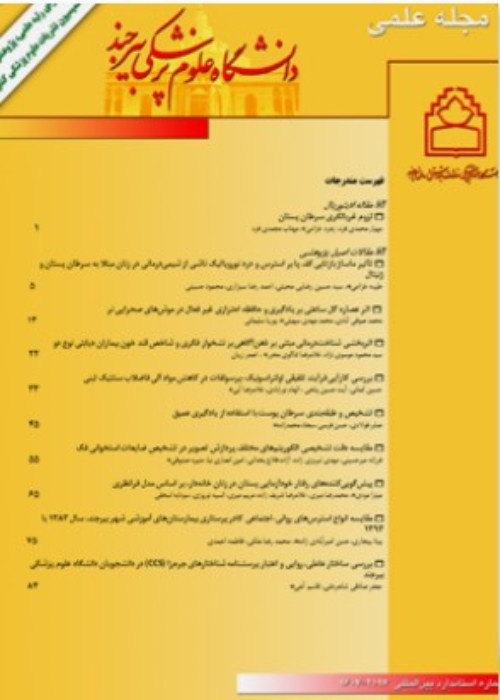Study of myopic risk factors in myopic and non- myopic students of Birjand students of medical sciences
Author(s):
Abstract:
Background And Aim
Prevalence of myopia in various races, at different ages, and in different places has been reported variously. The present study was carried out to compare myopia risk factors in myopic and non- myopic medical science students. Materials And Methods
In this case-control study, after ophthalmologic examination of all Birjand medical students in 2001 myopic students were taken as the case group and non-myopic ones as the control group Members of the two groups were homogeneous with respect to age, sex, term and course of study. Personal data and myopia risk factors were gathered by means of a specialized questionnaire. The obtained data was analyzed by means of SPSS software and inferential and descriptive statistics independent t-test, paired t-test, and 2 test. P0/05 was considered as the significant level. Results
Totally, 750 students were examined of whom 180 students were myopic and 168 cases were non-myopic. Prevalence of myopia was 24% among the students. Mean age of myopia onset was 14.6 in males and 13.6 in females. In most cases (63.6%) the onset age was between 11 and 17. Myopia prevalence in medical students was 50%, in associates 56.7%, and in undergraduates 46%. There was a statistically significant relationship between myopia of students and their parents’ myopia (P<0.0001). Most of the myopic students were 18-21 years old (54%). In order to correct myopia, 86.5% of all cases wore spectacles, 1.68% had undergone laser surgery and 0.5% used contact lenses. There was no significant relationship between severity of myopia in the two eyes at the beginning of myopia but at the time of this study there was a significant relationship (P<0.01). It was found that using spectacles or lenses full-time or part-time had a significant relationship with progress of myopia (P<0.000). Regarding TV watching distance there was no significant relationship but it was significant with respect to hours of study, book-eye distance and full/part time spectacle wearing in the two groups (P<0.01). Conclusion
Regarding the findings of this study, school health teachers are recommended to advise students on keeping proper distance of eye from reading materials. A comparative study of myopia and its causes in the youth and middle-aged individuals is recommended.Language:
Persian
Published:
Birjand University of Medical Sciences, Volume:14 Issue: 2, 2007
Page:
41
magiran.com/p496567
دانلود و مطالعه متن این مقاله با یکی از روشهای زیر امکان پذیر است:
اشتراک شخصی
با عضویت و پرداخت آنلاین حق اشتراک یکساله به مبلغ 1,390,000ريال میتوانید 70 عنوان مطلب دانلود کنید!
اشتراک سازمانی
به کتابخانه دانشگاه یا محل کار خود پیشنهاد کنید تا اشتراک سازمانی این پایگاه را برای دسترسی نامحدود همه کاربران به متن مطالب تهیه نمایند!
توجه!
- حق عضویت دریافتی صرف حمایت از نشریات عضو و نگهداری، تکمیل و توسعه مگیران میشود.
- پرداخت حق اشتراک و دانلود مقالات اجازه بازنشر آن در سایر رسانههای چاپی و دیجیتال را به کاربر نمیدهد.
In order to view content subscription is required
Personal subscription
Subscribe magiran.com for 70 € euros via PayPal and download 70 articles during a year.
Organization subscription
Please contact us to subscribe your university or library for unlimited access!


